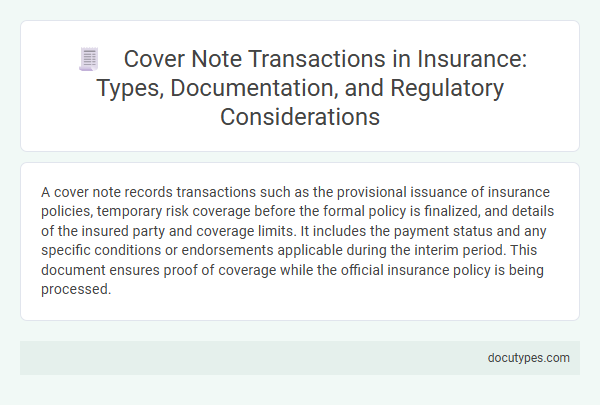A cover note records transactions such as the provisional issuance of insurance policies, temporary risk coverage before the formal policy is finalized, and details of the insured party and coverage limits. It includes the payment status and any specific conditions or endorsements applicable during the interim period. This document ensures proof of coverage while the official insurance policy is being processed.
Introduction to Cover Note Transactions in Insurance
A cover note is a temporary document issued by an insurance company to provide immediate proof of insurance coverage. It serves as a confirmation that an insurance policy is in process, detailing preliminary transaction details.
Transactions recorded with a cover note include the initiation of new policies, endorsements, and modifications before the final policy document is issued. These entries ensure accurate tracking of coverage, premium payments, and risk details during the interim period.
Understanding the Purpose of a Cover Note
What types of transactions are recorded with a cover note? A cover note documents temporary insurance coverage before the formal policy is issued. It records details such as the insured risk, coverage period, and premium payments.
How does a cover note serve its purpose in insurance transactions? It provides proof of insurance and outlines the terms agreed upon during the interim period. This ensures the insured party has immediate protection while the full policy is being processed.
Types of Cover Note Transactions
Cover notes typically record transactions related to the temporary insurance coverage provided before a formal policy is issued. These transactions include the initiation of new policies, amendments to existing coverage, and proof of coverage during the underwriting process.
Other types of cover note transactions involve endorsements that adjust policy terms, cancellations before policy inception, and renewals pending final approval. You rely on these recorded transactions to validate your insurance status and ensure continuous protection.
Key Features of Insurance Cover Notes
Insurance cover notes record critical transactions that establish temporary insurance coverage before the formal policy issuance. These documents capture the essential details required to confirm risk acceptance by the insurer.
- Risk Acceptance - The cover note registers the insurer's agreement to temporarily cover specified risks during the policy processing period.
- Premium Payment - It documents the receipt or terms of the initial premium payment securing provisional insurance protection.
- Policy Details - Key information such as insured party, coverage limits, and risk description are recorded to validate the scope of temporary coverage.
Essential Documentation for Issuing Cover Notes
A cover note records essential insurance transactions such as the issuance of temporary coverage before a formal policy is finalized. It details the insured risk, transaction date, and premium paid, providing proof of insurance during this interim period. You receive crucial documentation ensuring immediate protection while awaiting your full insurance policy.
Procedures for Cover Note Issuance and Validation
| Type of Transaction | Details |
|---|---|
| Policy Initiation | Records the issuance of a temporary insurance contract, providing immediate coverage before the formal policy is finalized. |
| Risk Assessment Confirmation | Documents the acceptance of preliminary risk evaluation allowing coverage commencement under specified terms. |
| Premium Payment Acknowledgment | Logs the receipt of initial premium payment confirming financial commitment related to the cover note. |
| Coverage Validation | Includes verification steps to ensure the cover note accurately reflects agreed terms, conditions, and coverage limits. |
| Duration Tracking | Records the active period during which the cover note is valid, detailing start and expiry dates of temporary coverage. |
| Amendments and Endorsements | Captures updates, modifications, or cancellations made to the cover note before policy issuance. |
| Issuance Procedure Steps | Includes documentation of customer information verification, risk evaluation approval, data entry, and official communication of the cover note. |
| Validation Procedures | Encompasses checks for accuracy, compliance with underwriting guidelines, confirmation of payment clearance, and authorization by relevant personnel. |
Regulatory Framework Governing Cover Notes
Cover notes document insurance transactions that provide temporary coverage before a formal policy is issued. These include new policy initiations, endorsements, and renewals, ensuring immediate protection for the insured party.
The regulatory framework governing cover notes mandates accurate recording of transaction details such as insured risk, coverage period, and premium amount. Regulators require insurers to issue cover notes promptly to comply with transparency and consumer protection laws. Your insurer must maintain these records to ensure clear proof of interim coverage and avoid regulatory penalties.
Compliance Requirements for Insurers and Agents
Cover notes record key transactions to ensure compliance with insurance regulations. They document preliminary agreements that protect all parties before the final policy is issued.
- New Insurance Agreements - Cover notes formally acknowledge the initiation of insurance coverage before the full policy is issued.
- Policy Amendments - They record any interim changes or endorsements requested by the insured or agent, maintaining regulatory transparency.
- Premium Payments - Cover notes document initial premium transactions to comply with financial and auditing standards for insurers and agents.
Risks and Limitations Associated with Cover Notes
A cover note records preliminary insurance transactions, providing temporary proof of coverage before a formal policy is issued. It outlines the risks insured and the terms under which coverage is granted but does not guarantee full insurance protection.
- Temporary Coverage - A cover note provides short-term insurance protection pending the issuance of the full policy.
- Risk Identification - It specifies the types of risks covered, such as property damage or liability, within a limited timeframe.
- Coverage Limitations - The document often contains conditions and exclusions that limit the insurer's liability during the interim period.
Coverage under a cover note may be subject to cancellation or modification, emphasizing the importance of obtaining the final policy promptly.
What Types of Transactions Are Recorded With a Cover Note? Infographic

